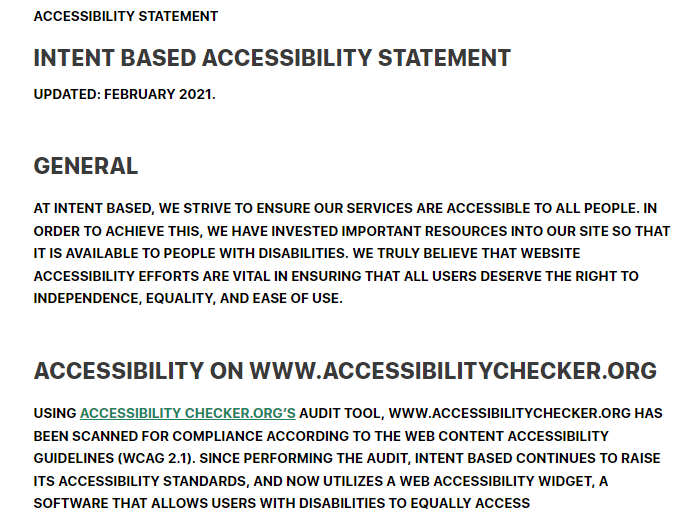A Basic Guide on How to Generate an Accessibility Statement
An accessibility statement is a great way to show your commitment to making your website accessible.
This might seem like another long page of terms, conditions, and information, but it’s important.
In this article, we outline everything you need to know about an accessiblity statement and how it can protect you against ADA-related lawsuits.
If you’re in a hurry, you can use our free Accessibility Statement Generator.
What Is an Accessibility Statement?
An accessibility statement is a public page that provides visitors with information on your organization’s policies and accessibility goals and successes. Basically, it answers any questions a visitor might have about your website’s accessibility features.

An accessibility statement is a great way to promote your accessibility objectives and ensure that everyone knows exactly what your brand stands for.
Overall, an accessibility statement fulfills the following purposes:
- It gives detailed information about a website’s accessibility goals as well as how they aim to achieve them.
- It helps website owners discover where there are still accessibility issues that need to be dealt with.
- It shows your dedication to online accessibility and inclusivity.

Benefits of a Web Accessibility Statement
An accessibility statement on your website can serve several purposes. Some benefits include:
- Reflects your intention and commitment to make your website accessible. An accessibility statement shows people how you’re going above and beyond legal requirements to ensure that disabled people can access your products too. It also engages a new section of the market, turning them into loyal customers.
- It can reduce your legal risks. An accessibility statement serves as a notice that tells plaintiff firm trolls to move along. If you have an accessibility statement, most of them will just skip to the next website on the list.
- Renders information on how your content is accessible. When a differently-abled person reads your accessibility statement, it’s probably because they have questions about accessing your site. Thus, your statement should address any questions that disabled website visitors might have.
- It shows your visitors that you consider accessibility to be important. A primary goal of generating an accessibility statement may be complying with legal requirements. However, it also allows you to engage with differently-abled customers by ensuring they have the same experience as all other customers. ADA demand letters are on the rise and SMB’s are in the middle of the storm. In order to fully protect yourself from ADA related lawsuits, you can choose one of the 3 automated solutions, which we highly recommend.
Difference Between a Web Accessibility Policy and Web Accessibility Statement
A web accessibility statement is a public proclamation of your commitment to attaining online accessibility. It shows that your organization cares about accessibility and the measures it is taking to be compliant.
On the other hand, a web accessibility policy is an internal document, available to both staff and customers, that highlights your accessibility goals and how you plan to achieve them.

How to Write a Web Accessibility Statement
If you don’t want to generate an automatic statement, you can also create one yourself. Here are some tips you can use to make sure that you’re writing an effective accessibility statement:
- Don’t use fancy language, jargon, or technical terms. Make sure your users understand what you mean.
- Include information about how users can get a personalized experience. This can include changing browser settings and using assistive technology.
- Be transparent about your site’s accessibility issues. Don’t make false claims or ignore them.
- Provide information about the person responsible for your website’s accessibility. Also include their contact information so that users can reach them.
If you’re having a hard time generating your accessibility statement, a statement generator can help.
Accessibility statement generators help you create a statement for your website, app, and other digital content. Generally, these tools ask for specific information to create a statement that’s tailored to your situation. You can also customize the statement afterwards.
Contents of a Web Accessibility Statement
Wondering what to include in your accessibility statement? These guidelines will help:
- Intent to provide an accessible website
If your website is not yet accessible, your statement should show your commitment to becoming ADA compliant. Aim to include your goal to adhere to WCAG guidelines.
- Guidelines that the website follows
When you make a claim in a statement, provide references to applicable national or local laws and policies.
In some cases, there are other web accessibility requirements (1) you should comply with, and your statement should reflect these too.
Here’s an example of what you would include in your statement:
Accessibility Checker’s audit tool has been designed with the Web Content Accessibility Guidelines (WCAG 2.2) in mind. Since performing an audit, (company name) continues to raise its accessibility standards, and now utilizes a web accessibility widget, software that allows users with disabilities to equally access (website name).
- Any known guideline exceptions
If there are any exceptions to the guidelines your site follows, your statement should reflect them to avoid frustrating visitors.
- Elements that you are still working on to make your website accessible
As we’ve mentioned, you should be transparent when generating an accessibility statement. This way, your users are informed of the possible accessibility barriers they might encounter.
- Contact details to report any complaints and difficulties
Lastly, you want to make it possible for visitors to contact you should they run into any issues. Your statement should provide a phone number, chat service, or email that users can easily reach.
Where to Publish an Accessibility Statement?
Now that you know how to generate an accessibility statement and what it should contain, it’s time to discuss where to put it.

The first thing to keep in mind is that an accessibility statement should be easy to find.
Consider putting it in the footer of your site, which appears on every page of your site.
However, you can also link to it from various places to help visitors find your accessibility statement more easily.
Also, remember to use consistent link names for your accessibility statements to help users recognize them more easily.
Now, say your website is not yet fully accessible. What should you do?
- If you have a website accessibility statement, update it to reflect that you’re aware of any issues and are correcting them.
- Ensure that your statement includes your accessibility goals and how users can reach you for assistance.
To Conclude
An accessibility statement is a sensitive document that should be on your website. While it may seem like a simple document, a few intricacies are involved, as discussed above.
Additionally, your website should have an accessibility statement even if it’s not yet fully accessible. This way, you can show users that you intend to become ADA compliant.
If you don’t know where to start, statement generators can be a great help.
Create your accessibility statement in no time at Accessibility Checker
Liked this article? Read more about accessibility below!


